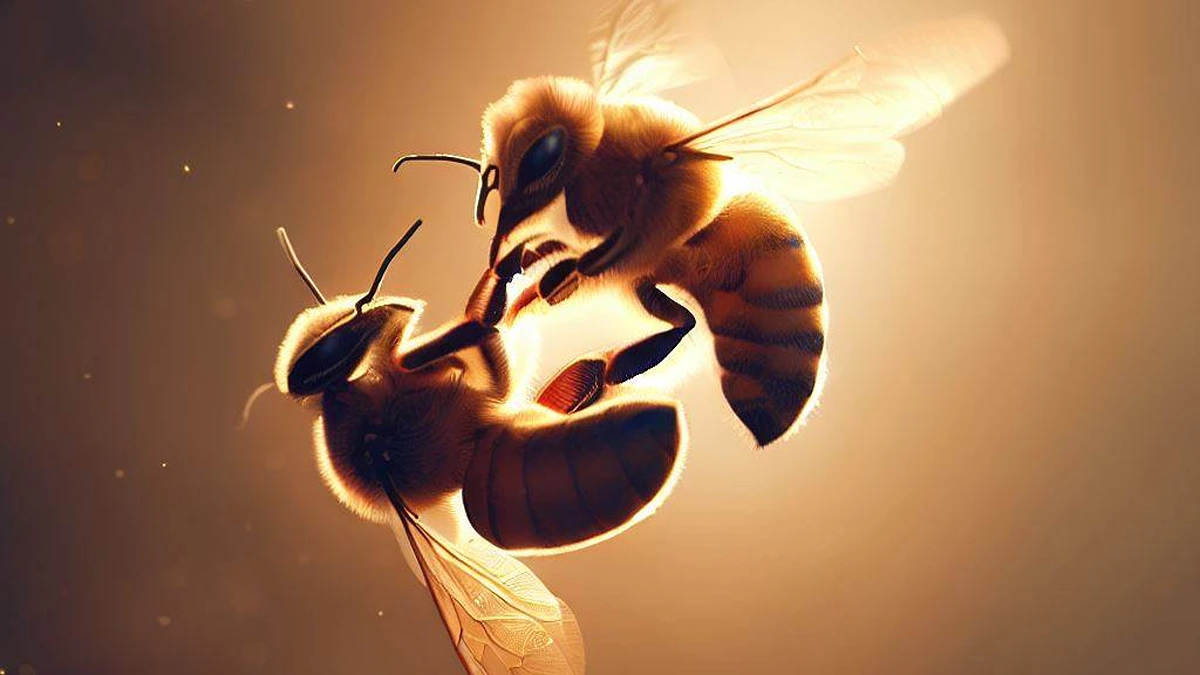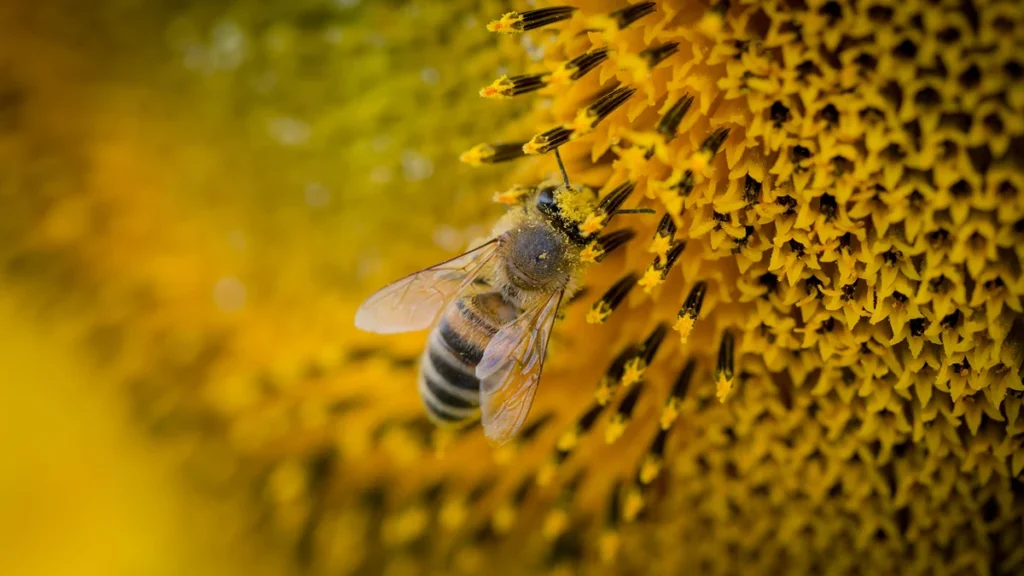
What is Metamorphosis?
Life cycle of honeybees is a whole process of developmental stages from egg to fully grown honey bee. This phenomenon of developmental stages is called metamorphosis. Metamorphosis is a term used in entomology, the study of insects. It is used to describe the process of transformation or development, particularly biological and natural changes in the stages of insect development. It is a Greek word which means “change in shape”; meta means “”change” or “transformation” while morphe means form” or “shape”.
Type of Metamorphosis
Generally there are two type of metamorphosis that insects undergo during their life cycle.
- Holometabolous
- Hemimetabolous
Holometabolous: Type of Metamorphosis
Holometabolous is a Greek word holo means “whole” or “complete and metabolous means “change” or “transformation”. This term is used to describe type of complete and comprehensive transformation of life cycle. In this type of metamorphosis is present in insects including beetles, butterflies, flies, and bees, also honey bees. In this type of metamorphosis insects go through four distinct stages:
- Stage 1: Egg development
- Stage 2: Larva development
- Stage 3: Pupa development
- Stage 4: Adult development

Hemimetabolous: Type of Metamorphosis
Hemimetabolous is a Greek word meaning “incomplete or partial transformation”. The prefix hemi means “half” or “part and metabolous means “change” or “transformation”. This type of metamorphosis refers to a type of incomplete metamorphosis which only involves three stages of development during life cycle.
- Stage 1: Egg development
- Stage 2: Nymph development
- Stage 3: Adult development
In this type of metamorphosis nymph resembles less developed version of the adult molts multiple times to acquire adult characteristics. This type of metamorphosis is characteristic of many insects including Grasshoppers, Cockroaches, True Bugs (Hemiptera), Dragonflies and Damselflies.
Type of life cycle of honeybees
Life cycle of honeybees is “holometabolo” which means honey bees go through all 4 distinct stages (eggs, larva, pupa and adult) during development and life cycle of honeybees. The whole process takes about 16 days for the queen bee, 18 to 22 days for the worker bees and 24 days for the male bees or drones. Nurses or worker bees take care for and feed throughout life cycle of honeybees under any developmental stage.
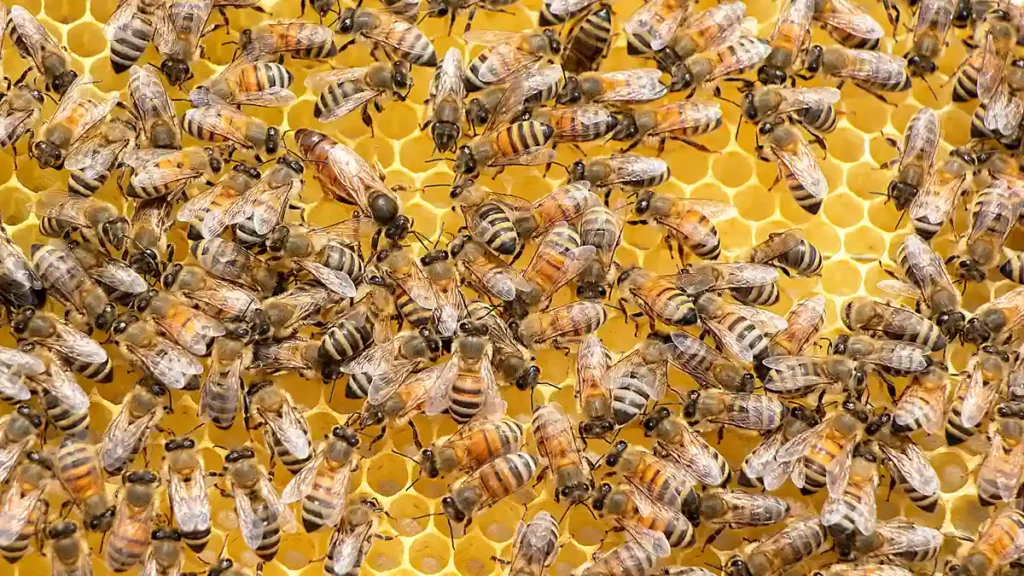
Steps of life cycle of honeybees
The life cycle of honeybees begins when a queen bee of an established colony starts laying eggs within individual cells inside a honeycomb or beehive.
Step 1: Mating flight
When a queen bee matures it immediately leaves hive and goes for mating flight to collect male genetic material from multiple drones of other hives for genetic diversity. Queen usually mates multiple times in the same flight, mid-air up to 24 times. Queen bee can store more than 5 million sperm cells inside their bodies in spermathecal, which enables them to lay eggs throughout their life after only one mating flight in life cycle of honeybees.
- 1. A queen flies out for mating at the age of 16 days, and produces pheromones to attract male drones for mating.
- 2. Drones follow the queen during flight and try to successfully clasps the queen with his legs, if he gets successful his endophallus (drone genitalia) protrudes and the process of mating occurs.
- 3. After mating, when they separate, part of endophallus remains inside the queen while drone dies eventually.

The impregnated queen returns back from the mating flight to join the rest of the colony in the beehive, and starts laying eggs that will develop into adult bees, completing life cycle of honeybees within 16-24 days approximately.
Polyandry
A queen generally mates with many drones, a mating behavior known as polyandry. Polyandry increases genetic diversity within a colony and therefore improves colony fitness and survival. Genetically diverse colonies have characteristics including increased population size, foraging activity, and abundant food supplies which ultimately favors the production of new queens and the formation of new colonies.
Step 2: Laying Eggs
Types of Eggs
Queen bees store the semen collected during mating flight from multiple drone bees. They have special structure called spermathecal where they store male genetic material. This structure also allow queen bees to control the fertilization of their eggs which makes queens capable of laying both unfertilized or fertilized eggs during the life cycle of honeybees.

Queen bees lay fertilized or unfertilized eggs while worker bees only lay unfertilized eggs in the absence of queen.The queen bee is responsible to lay enough fertilized eggs in order to produce enough well-developed force of worker bees for the colony.
Unfertilized eggs:
Unfertilized eggs develop into male bees or drones.
Fertilized eggs:
Fertilized eggs develop into females bees either worker bees or virgin queens.
Egg laying site
The queen lays a single egg in each yellowish colored wax hexagonal cell selected for brooding and the egg stands on its tip and poking upward in the very center of the hexagonal egg cell inside brood of honeybee hive. Each egg laid by the queen bee will land standing upright in the center of the cell.
Eggs destined to develop into a queen bees are deposited in a special cell, called a ‘queen cell’ which are larger and vertical cells as compared to other cells in the honeycomb or beehive while unfertilized eggs are laid in ‘drone cells’ which are larger cells than those of worker bees.
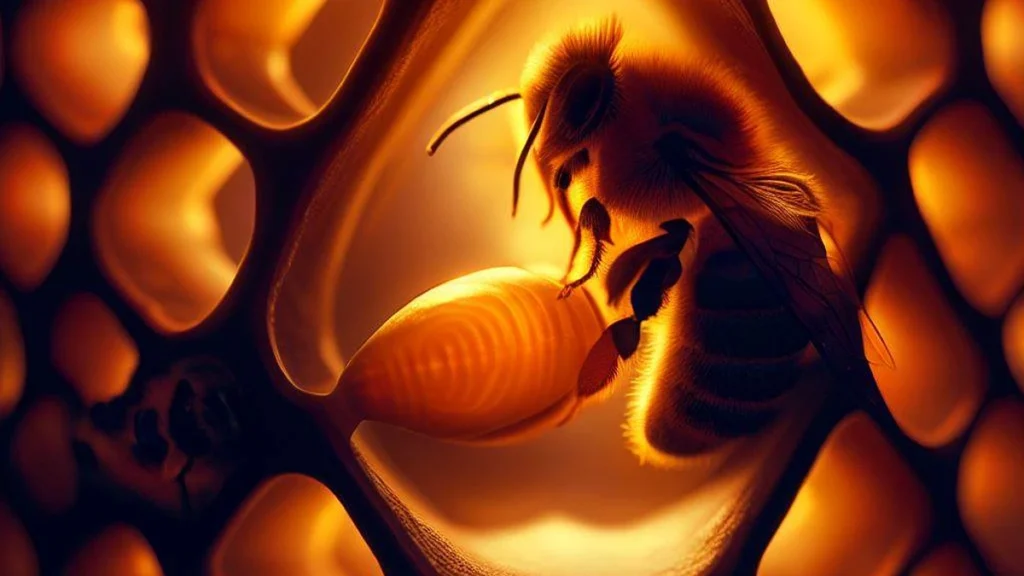
Size and number of eggs
The eggs of honey bees are small in size, whitish in color, and oval in shape having no segments. Honey bee egg measure approximately 1 mm long about the size of a grain of rice. A healthy and productive queen lays 2000 to 3000 eggs daily throughout the spring in the brood area of honeycomb. Queen bees before placing their eggs examine them side by side at the center of the comb frame with pollen surrounding them. The number of eggs laid by queen significantly diminishes with age of honey bee.
Brood is the area of honeycomb or beehive where there are eggs, larvae, or pupae in the cells. All the cells where queen lay eggs are generally grouped together and a productive and healthy queen leaves no empty cells without eggs in a brood. As the queen age, it also become unable to place the eggs closely together, resulting in a patchy comb inside a brood.
Step 3: Larval development
At third day, laying eggs will tip over and lean against the wall of its cell and the larvae emerge from eggs. After hatching from the egg, the larvae curl into a C-shape at the bottom of the cell. The larvae are white in color with wet sheen and limbless. After three days of laying, eventually egg hatches into a worm-like structure called “larva” having appearance like a whitish colored curled up having no legs, wings or antenna.
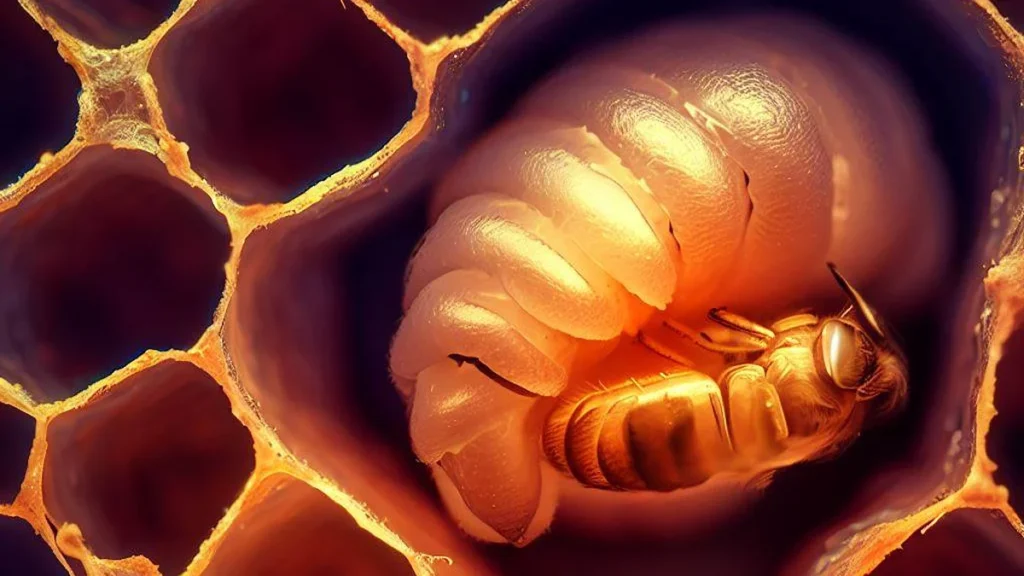
Feeding of larva
At this stage of life cycle of honeybees, larva is completely blind and fed by other worker bees inside the hexagonal cells of beehive as they grow. Every larva is visited multiple times a day to make sure they have everything they need. Worker bees make sure to fill all available space in each cell of brood with food to keep the larvae fed and grow properly.
Type of feed
Initially, all larva are fed with a substance secreted from the glands of the worker bees or nurse bees called “royal jelly” but after 2-3 days only queen bees in queen cell are fed with royal jelly while other larvae destined to develop into worker bees and drones at the end of life cycle of honeybees are switched to regular worker jelly or “bee bread”. However, adult worker bees feed on pollen and honey.
Bee milk
Royal jelly is a substance made by young worker bees in salivary glands of honeybees present inside the worker bee’s head (worker bees of between 5 and 14 days old produce royal jelly). Royal jelly also called bee milk contains water, protein, vitamins, fats (lipids), and sugar and some mineral salts.
Bee Bread
Worker jelly or “bee bread” is mixture of pollen collected by worker bees along with honey. Honey fulfils carbohydrate requirement of honeybees while pollen provides all protein source nutrition required for growth of bees. Worker jelly is slightly different than royal jelly as it contains less protein.
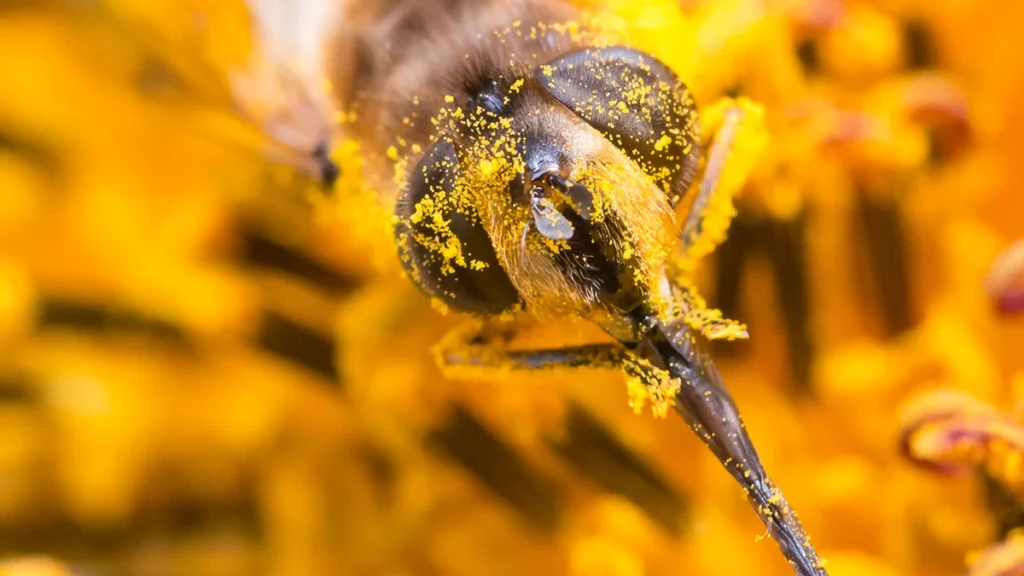
Transition to pupa (molting)
As the larvae grow older, worker bees visit them more frequently because they need more and more food as life cycle of honeybees progress. As the size of larva increases rapidly, to accommodate increasing size of larva it molts or sheds their outer skin, several times during this stage in life cycle of honeybees.
Step 4: Pupal development
After about 6 days, the egg cells are covered with a layer of wax by the worker bees. During this adult worker bees “cap” or “seal” the hexagonal cell inside brood having larvae at this stage called “pupa” with wax so it may finish developmental stages of life cycle of honeybees inside the cell and hatch out as fully grown adult bee. When the cell is sealed with wax it appears be flat and sealed with an orange-brown color and called “capped cells”.
Within the cell, pupa spins a cocoon around its body. Inside the cocoon the pupa develops wings, legs, head, eyes, thorax and abdomen and resemble like an adult bee. The chemical signal in the form of an odor produced by larva to be capped is also considered as an invite signal by the Varroa destructor mite-parasite as an opportunity to hide inside cell and halt the life cycle of honeybees at this stage.
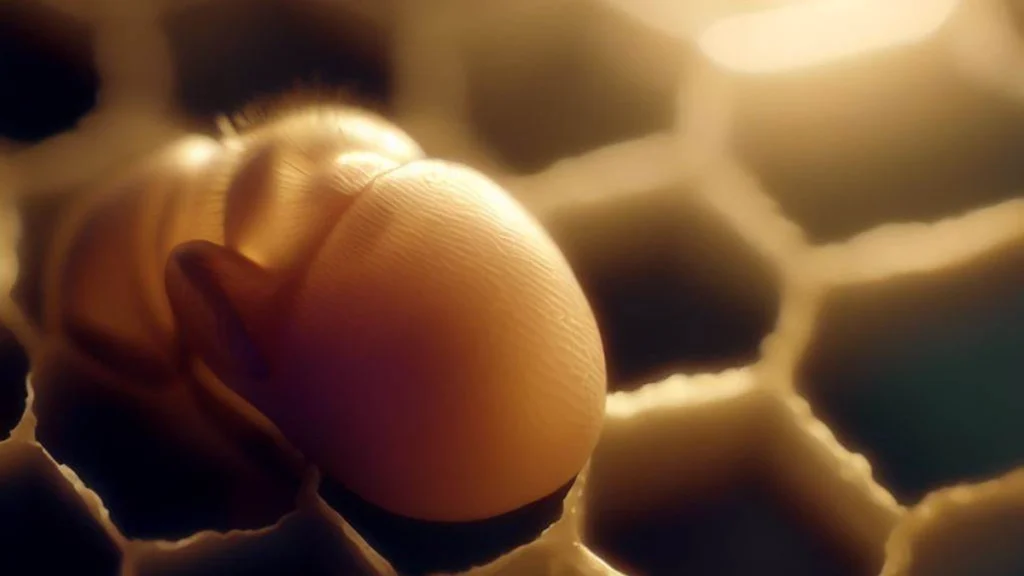
Adult Honeybee
Finally, a young adult honey bee will emerge from the hexagonal shaped egg cell, ready to work for honey bee hive after completing life cycle of honeybees stages. Usually it takes about 7 to 14 days for pupa to chew the wax capping around its body and make its way out and then hatches out of the cell as fully grown honeybee, somewhere between 18-22 day later, ready to work. (Queen bee emerges at day 16, worker bees require between 18 and 22 days to fully develop, while drones need 24 days to fully develop as fully grown bee).
A fully grown honey bee can be spotted due to their new born appearance as they are covered with fluffy blond hairs. After emerging as adult bee, the queen bees fight among themselves until only one queen remains in the beehive to propagate life cycle of honeybees.

Swarming in life cycle of honeybees
The old queen bees and the majority of worker bees, typically called swarm, leave the beehive by the time the new queens emerge. The swarm find new sites to develop a new colony or beehive at different nesting sites and start new life cycle of honeybees.
| Summary of life cycle of honey bees | |||
| Queen Bee | Worker Bee | Drone Bee | |
| Total lifecycle length | 16 days | 18-22 days | 24 days |
| Larva stage duration | Upton 5 1/2 days (till 8 1/2 days after being laid as an egg) | 6 days (till day 9 from being laid) | 6 1/2 days (till 9 1/2 days from being laid) |
| Pupa stage duration | 8 days | 12 days | 14 1/2 days |
| Day at which cells are capped | about 7 1/2 days after the egg was laid (day before transition to pupa) | at about 9 days( as the same day as transition occur) | at about 10 days (day after transition to pupa) |
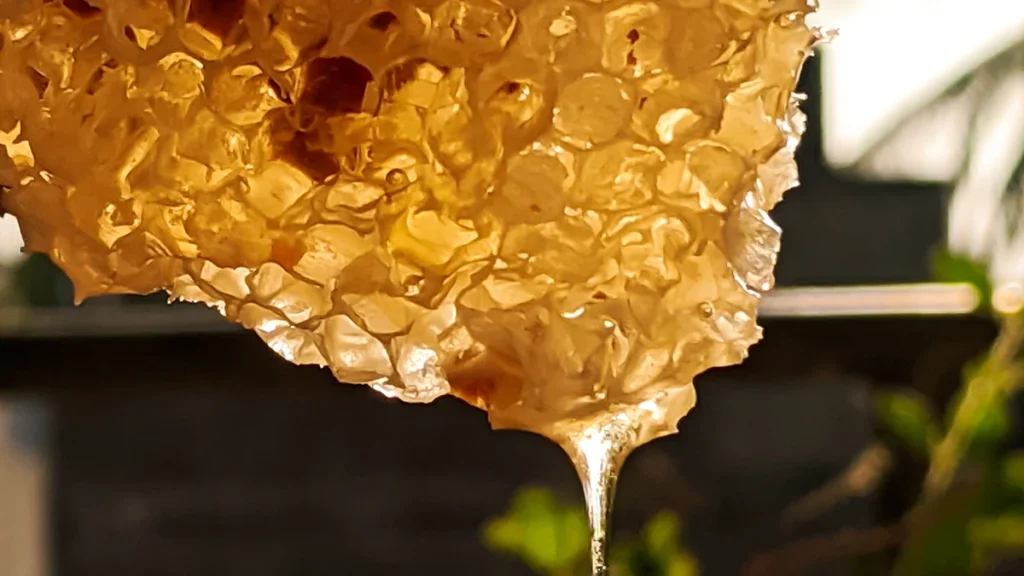
Frequently Asked Questions
What is the type of life cycle of honeybees?
Life cycle of honeybees is “holometabolo” having four distinct developmental stages including eggs, larva, pupa and adult during development and life cycle of honeybees. The entire process takes about 16 days for the queen bee, 18 to 22 days for the worker bees and 24 days for the male bees or drones to complete life cycle of honeybees.
What is bee bread?
Bee bread also called worker jelly is mixture of pollen collected by worker bees during foraging along with honey. Honey fulfils carbohydrate requirement of honeybees while pollen provides all protein source nutrition required for growth of bees.
What is bee milk?
Bee milk also called “royal jelly” is a substance produced by young worker bees between 5 to 14 days old. Royal jelly contains water, protein, vitamins, fats (lipids), and sugar and some mineral salts and fed to queen bees throughout their developmental stages.
What does it mean by brood?
Brood is the area inside the honeycomb or beehive where eggs, larvae, or pupae are present inside the hexagonal cells. All the cells where queen laid eggs are generally grouped together and collectively this area is called brood.
How does a fully grown honey bee look like?
When a new bee is born, she will be covered in fluffy blond hairs. You can always spot these ladies by their “new born” appearance.
